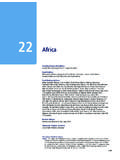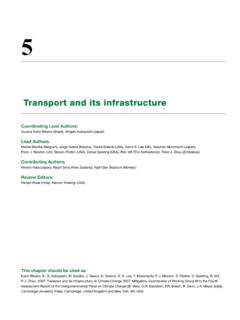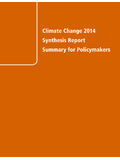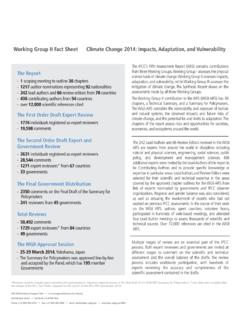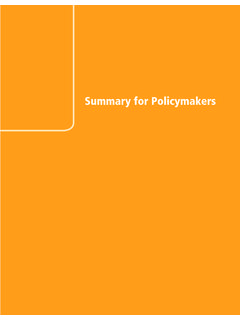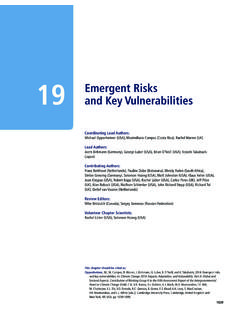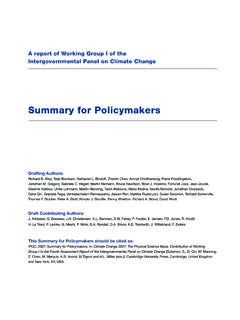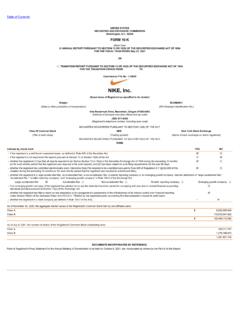Transcription of Transport of CO2 - IPCC
1 4. Transport of CO2. Coordinating Lead Authors Richard Doctor (United States), Andrew Palmer (United Kingdom). Lead Authors David Coleman (United States), John Davison (United Kingdom), Chris Hendriks (The Netherlands), Olav Kaarstad (Norway), Masahiko Ozaki (Japan). Contributing Author Michael Austell (United Kingdom). Review Editors Ramon Pichs-Madruga (Cuba), Svyatoslav Timashev (Russian Federation). 180 IPCC Special Report on Carbon dioxide Capture and Storage Contents Executive Summary 181 Risk, safety and monitoring 187. Introduction 187. Introduction 181 Land pipelines 187. Marine pipelines 188. Pipeline systems 181 Ships 188. Pipeline transportation systems 181. Existing experience 182 Legal issues, codes and standards 189. Design 184 International conventions 189. Construction of land pipelines 184 National codes and standards 189. Underwater pipelines 185. Operations 185 Costs 190. Costs of pipeline Transport 190.
2 Ships for CO2 transportation 186 Costs of marine transportation systems 190. Marine transportation system 186. Existing experience 186 References 192. Design 186. Construction 186. Operation 187. Chapter 4: Transport of CO2 181. Executive Summary (liquefied petroleum gas) and LNG (liquefied natural gas). This existing technology and experience can be transferred to Transport is that stage of carbon capture and storage that links liquid CO2 Transport . Solidification needs much more energy sources and storage sites. The beginning and end of Transport ' compared with other options, and is inferior from a cost and may be defined administratively. Transport ' is covered by energy viewpoint. Each of the commercially viable technologies the regulatory framework concerned for public safety that is currently used to Transport carbon dioxide. governs pipelines and shipping. In the context of long-distance Research and development on a natural gas hydrate carrying movement of large quantities of carbon dioxide, pipeline system intended to replace LNG systems is in progress, and the Transport is part of current practice.
3 Pipelines routinely carry results might be applied to CO2 ship Transport in the future. In large volumes of natural gas, oil, condensate and water over pipeline transportation, the volume is reduced by transporting distances of thousands of kilometres, both on land and in the at a high pressure: this is routinely done in gas pipelines, where sea. Pipelines are laid in deserts, mountain ranges, heavily- operating pressures are between 10 and 80 MPa. populated areas, farmland and the open range, in the Arctic and A transportation infrastructure that carries carbon dioxide sub-Arctic, and in seas and oceans up to 2200 m deep. in large enough quantities to make a significant contribution Carbon dioxide pipelines are not new: they now extend to climate change mitigation will require a large network of over more than 2500 km in the western USA, where they carry pipelines. As growth continues it may become more difficult 50 MtCO2 yr-1 from natural sources to enhanced oil recovery to secure rights-of-way for the pipelines, particularly in highly projects in the west Texas and elsewhere.
4 The carbon dioxide populated zones that produce large amounts of carbon dioxide. stream ought preferably to be dry and free of hydrogen sulphide, Existing experience has been in zones with low population because corrosion is then minimal, and it would be desirable to densities, and safety issues will become more complex in establish a minimum specification for pipeline quality' carbon populated areas. dioxide. However, it would be possible to design a corrosion- The most economical carbon dioxide capture systems resistant pipeline that would operate safely with a gas that appear to favour CO2 capture, first, from pure stream sources contained water, hydrogen sulphide and other contaminants. such as hydrogen reformers and chemical plants, and then from Pipeline Transport of carbon dioxide through populated areas centralized power and synfuel plants: Chapter 2 discusses this requires attention be paid to design factors, to overpressure issue in detail.
5 The producers of natural gas speak of stranded'. protection, and to leak detection. There is no indication that the reserves from which Transport to market is uneconomical. A. problems for carbon dioxide pipelines are any more challenging movement towards a decentralized power supply grid may make than those set by hydrocarbon pipelines in similar areas, or that CO2 capture and Transport much more costly, and it is easy to they cannot be resolved. envision stranded CO2 at sites where capture is uneconomic. Liquefied natural gas and petroleum gases such as propane A regulatory framework will need to emerge for the low- and butane are routinely transported by marine tankers; this greenhouse-gas-emissions power industry of the future to guide trade already takes place on a very large scale. Carbon dioxide investment decisions. Future power plant owners may find the is transported in the same way, but on a small scale because of carbon dioxide Transport component one of the leading issues in limited demand.
6 The properties of liquefied carbon dioxide are their decision-making. not greatly different from those of liquefied petroleum gases, and the technology can be scaled up to large carbon dioxide Pipeline systems carriers. A design study discussed later has estimated costs for marine Transport of 1 MtCO2 yr-1 by one 22,000 m3 marine Pipeline transportation systems tanker over a distance of 1100 km, along with the associated liquefaction, loading and unloading systems. CO2 pipeline operators have established minimum specifications Liquefied gas can also be carried by rail and road tankers, for composition. Box gives an example from the Canyon but it is unlikely that they be considered attractive options for Reef project (Section ). This specification is for gas for large-scale carbon dioxide capture and storage projects. an enhanced oil recovery (EOR) project, and parts of it would not necessarily apply to a CO2 storage project.
7 A low nitrogen Introduction content is important for EOR, but would not be so significant for CCS. A CO2 pipeline through populated areas might have a CO2 is transported in three states: gas, liquid and solid. lower specified maximum H2S content. Commercial-scale Transport uses tanks, pipelines and ships for Dry carbon dioxide does not corrode the carbon-manganese gaseous and liquid carbon dioxide. steels generally used for pipelines, as long as the relative humidity Gas transported at close to atmospheric pressure occupies is less than 60% (see, for example, Rogers and Mayhew, 1980);. such a large volume that very large facilities are needed. Gas this conclusion continues to apply in the presence of N2, NOx occupies less volume if it is compressed, and compressed and SOx contaminants. Seiersten (2001) wrote: gas is transported by pipeline. Volume can be further reduced The corrosion rate of carbon steel in dry supercritical CO2.
8 By liquefaction, solidification or hydration. Liquefaction is is low. For AISI 1080 values around mm yr-1 have been an established technology for gas Transport by ship as LPG measured at 90 120 bar and 160 C 180 C for 200 days. Short- 182 IPCC Special Report on Carbon dioxide Capture and Storage term tests confirm this. In a test conducted at 3 C and 22 C at below, and the reader is referred to Annex I for a discussion of 140 bar CO2, and 800 to 1000 ppm H2S, the corrosion rate for the physical properties of CO2. X-60 carbon steel was measured at less than m yr-1 ( mm yr-1). Field experience also indicates very few problems Existing experience with transportation of high-pressure dry CO2 in carbon steel pipelines. During 12 years, the corrosion rate in an operating Table lists existing long-distance CO2 pipelines. Most of the pipeline amounts to m yr-1 ( to ( mm projects listed below are described in greater detail in a report by yr-1).)
9 The UK Department of Trade and Industry (2002). While there The water solubility limit in high-pressure CO2 (500 bar) is are CO2 pipelines outside the USA, the Permian Basin contains 5000 ppm at 75 C and 2000 ppm at 30 C. Methane lowers the over 90% of the active CO2 floods in the world (O&GJ, April solubility limit, and H2S, O2 and N2 may have the same effect. 15, 2002, EOR Survey). Since then, well over 1600 km of new Corrosion rates are much higher if free water is present; CO2 pipelines has been built to service enhanced oil recovery hydrates might also form. Seiersten (2001) measured a corrosion (EOR) in west Texas and nearby states. rate of mm yr-1 corrosion rate in 150 to 300 hours exposure at 40 C in water equilibrated with CO2 at 95 bar, and higher Canyon Reef rates at lower pressures. She found little difference between The first large CO2 pipeline in the USA was the Canyon Reef carbon-manganese steel (American Petroleum Institute grade Carriers, built in 1970 by the SACROC Unit in Scurry County, X65) and chromium corrosion-resistant alloy.
10 It is unlikely Texas. Its 352 km moved 12,000 tonnes of anthropogenically to be practicable to Transport wet CO2 in low-alloy carbon produced CO2 daily ( Mt yr-1) from Shell Oil Company gas steel pipelines because of this high corrosion rate. If the CO2 processing plants in the Texas Val Verde basin. cannot be dried, it may be necessary to build the pipeline of a corrosion-resistant alloy ( stainless steel'). This is an established Bravo Dome Pipeline technology. However the cost of steel has greatly increased Oxy Permian constructed this 508 mm (20-inch) line connecting recently and this may not be economical. the Bravo Dome CO2 field with other major pipelines. It is Once the CO2 has been dried and meets the transportation capable of carrying MtCO2 yr-1 and is operated by Kinder criteria, the CO2 is measured and transported to the final use Morgan. site. All the pipelines have state-of-the-art metering systems that accurately account for sales and deliveries on to and out of each Cortez Pipeline line, and SCADA (Supervisory Control and Data Acquisition) Built in 1982 to supply CO2 from the McElmo Dome in systems for measuring pressure drops, and redundancies Colorado, the 762 mm (30-inch), 803 km pipeline carries built in to allow for emergencies.


